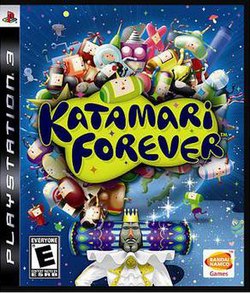Story and gameplay
Katamari Forever contains 34 stages, with all but three of the stages being taken from previous titles in the series. [6] Half of the stages take place within the mind of the King of All Cosmos, who gets knocked in the head and suffers from amnesia. The levels are black-and-white in appearance, and the objective is to roll up junk to bring color back to the stages, restoring the King's memory. The other half of the stages take place in the present, where RoboKing, a robotic version of the King of All Cosmos created by the Prince and his cousins, goes on a rampage and destroys all the stars in the sky, which, unlike the King, he feels extremely remorseful for.
The objective of the new levels involves creating stars by rolling up junk as in previous Katamari games. [5] New additions to the gameplay include: the "Prince Hop", which allows the Prince to hop into the air by flicking the controller up or pressing a shoulder button; and the "King Shock", which sucks nearby objects onto the katamari like a magnet. [5]
Katamari Forever lacks the online multiplayer mode as in Beautiful Katamari , but does include local multiplayer and online leaderboards. The game utilizes a full high-definition video format. [7] In addition to graphics in the original style of Katamari Damacy , the game allows the players to select graphic filters such as cel-shaded, colored pencil, or wood grain graphics. [8]
Reception
Katamari Forever was met with positive to average reception upon release. GameRankings gave it a score of 77.80%, [10] while Metacritic gave it 74 out of 100. [11]
The game received a score of 33 out of 40 by Japanese gaming publication Famitsu . [15] It was the 6th best-selling game in Japan during the week of its release, selling 28,000 units. [23] In America, IGN awarded the game 7 out of 10, noting that the game still suffered from many of the issues that plagued past entries in the series. [21] GameSpot also gave it 7 out of 10, commending its gameplay, but thought that the title did not bring anything new to the series. [18] PixlBit awarded the game 4 of 5 stars, recommending the game to both fans of the series and newcomers alike. [24]
This page is based on this
Wikipedia article Text is available under the
CC BY-SA 4.0 license; additional terms may apply.
Images, videos and audio are available under their respective licenses.
